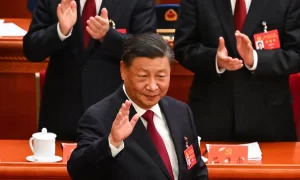Introduction
The American chip dream, once synonymous with innovation and technological leadership, faces numerous challenges that threaten its position in the global semiconductor industry.
In recent years, the United States has encountered several setbacks that have hampered its ability to maintain its competitive edge.
In this blog post, we will delve into the key reasons behind the weakening of the American chip dream and explore potential solutions to reignite its prominence.
Read More :China Can Make 5nm Chips Without US Technology – techovedas
1. Easing Restrictions on Critical Equipment Sales
One significant challenge has been the shift in policy regarding the sale of chipmaking equipment to Chinese companies.
In 2019, the Trump administration-imposed bans on such sales, aiming to curb China’s chipmaking capabilities.
However, these restrictions inadvertently hurt American chipmakers who rely on equipment from companies like ASML.
While the American Chip Dream Biden administration has taken steps to lift some of these restrictions, the impact remains uncertain.
Striking a balance between national security concerns and supporting domestic chip manufacturing is crucial.
Read more: US Exempts South Korea, Taiwan Chipmakers from China Export Curbs
2. Intel’s Struggles to Innovate
Intel, once the juggernaut of the chipmaking industry, has encountered difficulties in recent years.
The American Chip company has fallen behind its competitors due to a sluggish adoption of new technologies and outdated manufacturing facilities & nodes.
Consequently, Intel has been forced to outsource production to TSMC, a Taiwanese company.
For the American chip dream to thrive, Intel must rekindle its spirit of innovation and invest in cutting-edge technology and manufacturing processes.
Read more: The Fall of Intel: How an MBA CEO’s Short term thinking destroyed a semiconductor giant
3. Delays in Chip Fab Construction
The Biden administration has announced substantial investments in new chip fabs to bolster domestic production with TSMC.
However, the American Chip Dream construction of these facilities has faced setbacks, including global chip shortages and a shortage of skilled workers.
Addressing these challenges is imperative for the United States to secure its position in semiconductor manufacturing.
Read more: TSMC’s US Expansion: A Boon or a Burden?
4. The China Angle
China’s chipmaking industry is experiencing significant investments, both in terms of research and development and the construction of new chip fabs.
The Chinese government has set a target of achieving self-sufficiency in chip production by 2025.
One approach being pursued by China involves substantial investments in legacy chips.
These older chips may no longer be cutting-edge, but they continue to be in high demand for various applications.
By focusing on legacy chips, China is gaining valuable manufacturing experience and establishing a foothold in the chipmaking industry.
Another avenue towards China’s chipmaking objectives is through the efforts of SMIC, a Chinese semiconductor company currently developing 5nm chips.
These 5nm chips represent the pinnacle of current chip technology and find application in high-end devices such as smartphones and laptops.
If SMIC succeeds in producing 5nm chips, it would signify a significant breakthrough for China’s chip manufacturing industry.
China’s comprehensive approach to achieving chipmaking goals encompasses investments in research and development, as well as advancements in chip manufacturing equipment.
This multi-faceted strategy positions China as a formidable contender in the global chip market.
Specific instances of China’s investments in the chipmaking sector include:
- In 2021, a $1.5 trillion investment plan for the semiconductor industry was unveiled by the Chinese government.
- In 2022, SMIC secured $5.4 billion in funding from various investors, including the Chinese government.
- In 2023, the Chinese government disclosed plans for the construction of a new chip fab in Shanghai.
These examples illustrate China’s determined efforts to attain self-sufficiency in chip production, which could potentially have a substantial impact on the global chip market.
The competition between the United States and China for chip supremacy is anticipated to persist for several years. The outcome of this rivalry will wield significant influence over the global economy and the technological prowess of both nations.
Read more: China Can Make 5nm Chips Without US Technology
5. Additional Factors Affecting the American Chip Dream
Rising Costs: The increasing cost of chip manufacturing is making it difficult for American companies to compete.
To remain competitive, efforts should be made to optimize production processes and reduce manufacturing expenses.
Market Consolidation: The chipmaking industry is witnessing consolidation, with a few dominant companies controlling the market.
This trend makes it challenging for new entrants to compete. Encouraging healthy competition and fostering an environment conducive to startups is vital.
Investment in Research and Development: The United States must prioritize investment in research and development in the chipmaking space in order to come out of this race.
This is essential for not only staying on the cutting edge of technology but also for nurturing the next generation of semiconductor innovations.
Conclusion
The American chip dream is at a crossroads. While it faces significant challenges, it is not yet dead. To revive and sustain its leadership in the semiconductor industry
The United States must take decisive action. This includes finding a balance in export controls, reinvigorating innovation within established companies like Intel.
Expediting the construction of chip fabs, managing costs, encouraging competition, and robustly investing in research and development.
The world continues to rely on semiconductors for an array of technological advancements, from artificial intelligence to autonomous vehicles.
By addressing these challenges head-on, the United States can secure its place at the forefront of the semiconductor industry, ensuring that the American chip dream remains a beacon of innovation and technological progress for years to come.








